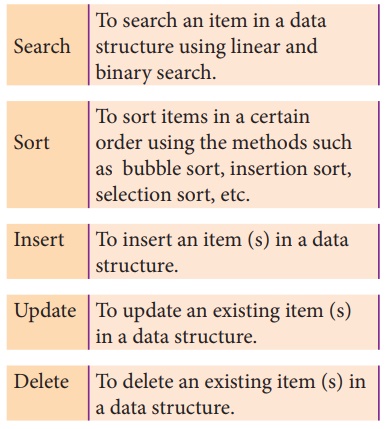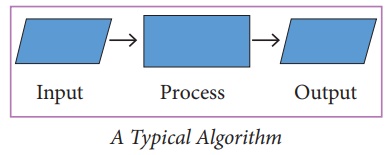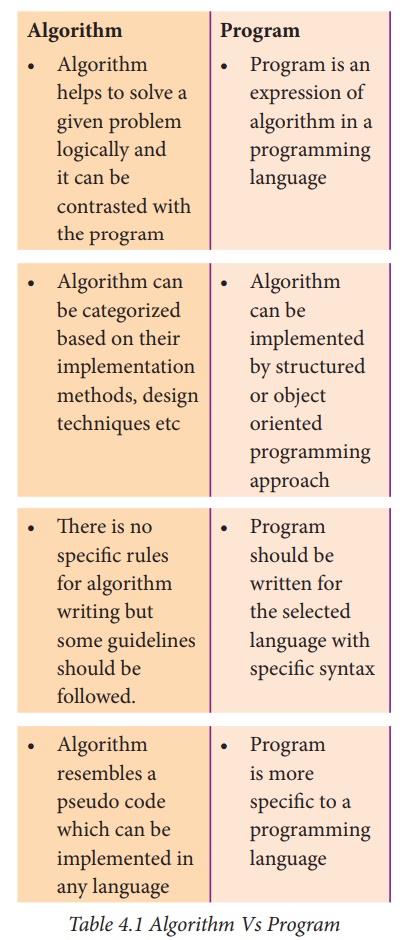Chapter: 12th Computer Science : Chapter 4 : Algorithmic Strategies
Introduction to Algorithmic strategies
Introduction to Algorithmic strategies
An algorithm is a finite set of instructions to
accomplish a particular task. It is a step-by-step procedure for solving a
given problem. An algorithm can be implemented in any suitable programming
language.
Algorithms must have input, output and should
satisfy the following characteristics such as definiteness, correctness and
effectiveness. Data are maintained and manipulated effectively through data
structures. Algorithms can be developed to store, manipulate and retrieve data
from such data structures. Examples for data structures are arrays, structures,
list, tuples, dictionary etc.
Search
To search an item in a data structure using
linear and binary search.
Sort
To sort items in a certain order using the
methods such as bubble sort, insertion sort, selection sort, etc.
Insert
To insert an item (s) in a data structure.
Update
To update an existing item (s) in a data
structure.
Delete
To delete an existing item (s) in a data
structure.

The way of defining an algorithm is called
algorithmic strategy. For example to calculate factorial for the given value n then it can be done by defining the
function to calculate factorial once for the iteration-1 then it can be called
recursively until the number of required iteration is reached.
Characteristics of an Algorithm
An algorithm should have the following characteristics:
Input
Zero or more quantities to be supplied.
Output
At least one quantity is produced.
Finiteness
Algorithms must terminate after finite number
of steps.
Definiteness
All operations should be well defined. For
example operations involving division by
zero or taking square root for negative number are unacceptable.
Effectiveness
Every instruction must be carried out
effectively.
Correctness
The algorithms should be error free.
Simplicity
Easy to implement.
Unambiguous
Algorithm should be clear and unambiguous. Each
of its steps and their inputs/outputs should be clear and must lead to only one
meaning.
Feasibility
Should be feasible with the available
resources.
Portable
An algorithm should be generic, independent of
any programming language or an operating system able to handle all range of
inputs.
Independent
An algorithm should have step-by-step
directions, which should be independent of any programming code.
Writing an Algorithm
Algorithms are generic and not limited to
computer alone. It can be used in various real time activities also. Knowingly
or unknowingly we perform many algorithms in our daily life such as packing
books in school bag, finding shortest path to search a place, scheduling
day-to-day activities, preparation for examination, etc. As we know that all
programming languages share basic code constructs like conditions and
iterations can be used to write an algorithm. A typical algorithm is shown in
the following Figure 4.1.

Example
Consider the example of Coffee preparation. To
make coffee, we need to have the following ingredients: Water, milk, coffee
powder and sugar. These ingredients are the inputs of an algorithm. Preparing a
cup of coffee is called process. The output of this process is coffee.
The procedure for preparing coffee is as follows:
1. Take a bowl with coffee powder
2. Boil the water and pour it into the bowl
3. Filter it
4. Boil milk
5. Mix sugar and filtered coffee along with
boiled milk
6. Pour the coffee into the cup to serve
This kind of procedure can be represented using
an algorithm. Thus, the algorithm consists of step-step-by instructions that
are required to accomplish a task and helps the programmer to develop the
program.
Problem: Design an algorithm to find square of the given number and display the result.
The algorithm can be written as:
Step 1 – start the process
Step 2 – get the input x
Step3 –calculate the square by multiplying the
input value ie., square ← x* x
Step 4 − display the result square
Step 5 − stop
Algorithm could be designed to get a solution
of a given problem. A problem can be solved in many ways. Among many algorithms
the optimistic one can be taken for implementation.

Analysis of Algorithm
Computer resources are limited. Efficiency of
an algorithm is defined by the utilization of time and space complexity.
Analysis of an algorithm usually deals with the
running and execution time of various operations involved. The running time of
an operation is calculated as how many programming instructions executed per
operation.
Analysis of algorithms and performance
evaluation can be divided into two different phases:
1. A Priori estimates: This is a theoretical performance analysis of an algorithm. Efficiency of an algorithm
is measured by assuming the external factors.
2. A Posteriori testing: This is called performance measurement. In this analysis, actual statistics like
running time and required for the algorithm executions are collected.
Related Topics